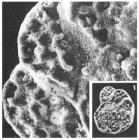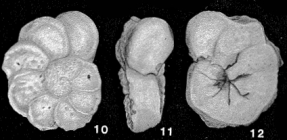Foraminifera taxon details
Boldia van Bellen, 1946 †
722340 (urn:lsid:marinespecies.org:taxname:722340)
accepted
Genus
Rotalina lobata Terquem, 1882 † accepted as Boldia lobata (Terquem, 1882) † (type by original designation)
Terquemia van Bellen, 1946 † · unaccepted (New name in van Bellen in van den...)
New name in van Bellen in van den Bold (1946) Homonym of Terquemia Tate, 1868 (Lamellibranch)
- Species Boldia carinata Cushman & Bermúdez, 1948 †
- Species Boldia claustrata (Terquem, 1882) †
- Species Boldia cubensis Cushman & Bermúdez, 1948 †
- Species Boldia dubia Haque, 1966 †
- Species Boldia hodgei (Cushman & Schenck, 1928) †
- Species Boldia lobata (Terquem, 1882) †
- Species Boldia madrugaensis Cushman & Bermúdez, 1948 †
- Species Boldia toeringae van Voorthuysen, 1969 †
- Species Boldia vandersluisi van den Bold, 1946 †
- Species Boldia variabilis Szczechura & Pożaryska, 1971 †
- Species Boldia vertebralis Guillevin, 1977 †
- Species Boldia reinholdi Pożaryska & Szczechura, 1970 † accepted as Scarificatina reinholdi (Pożaryska & Szczechura, 1970) † (Type species of Scarificatina)
marine, brackish, fresh, terrestrial
fossil only
feminine
Bold, W.A. (1946). Contribution to the Study of Ostracoda with Special Reference to the Tertiary and Cretaceous Microfauna of the Caribbean Region. Amsterdam, DeBussy, 1-167.
page(s): p. 124 [details] Available for editors [request]
[request]
Bellen, R. C. van. (1946). Some homonyms in "Foraminifera from the Middle Eocene in the southern part of the Netherlands Province of Limburg". <em>Contributions from the Cushman laboratory for foraminiferal research.</em> 22(4): 120-123., available online at https://cushmanfoundation.allenpress.com/Portals/_default/files/pubarchive/cclfr/22cclfr4.pdf
page(s): p. 122 [details] Available for editors [request]
[request]
page(s): p. 124 [details] Available for editors
Bellen, R. C. van. (1946). Some homonyms in "Foraminifera from the Middle Eocene in the southern part of the Netherlands Province of Limburg". <em>Contributions from the Cushman laboratory for foraminiferal research.</em> 22(4): 120-123., available online at https://cushmanfoundation.allenpress.com/Portals/_default/files/pubarchive/cclfr/22cclfr4.pdf
page(s): p. 122 [details] Available for editors
Hayward, B.W.; Le Coze, F.; Vachard, D.; Gross, O. (2024). World Foraminifera Database. Boldia van Bellen, 1946 †. Accessed at: https://www.marinespecies.org/foraminifera/aphia.php?p=taxdetails&id=722340 on 2024-04-18
Date
action
by
original description
Bold, W.A. (1946). Contribution to the Study of Ostracoda with Special Reference to the Tertiary and Cretaceous Microfauna of the Caribbean Region. Amsterdam, DeBussy, 1-167.
page(s): p. 124 [details] Available for editors [request]
[request]
original description Bellen, R. C. van. (1946). Some homonyms in "Foraminifera from the Middle Eocene in the southern part of the Netherlands Province of Limburg". <em>Contributions from the Cushman laboratory for foraminiferal research.</em> 22(4): 120-123., available online at https://cushmanfoundation.allenpress.com/Portals/_default/files/pubarchive/cclfr/22cclfr4.pdf
page(s): p. 122 [details] Available for editors [request]
[request]
original description (of Terquemia van Bellen, 1946 †) Bellen, R. C. van. (1946). Foraminifera from the middle Eocene in the southern part of the Netherlands Province of Limburg. <em>Mededelingen van de Geologische Stichting, ser. C.</em> 5(4): 1-144.
page(s): p. 86 [details]
basis of record Loeblich, A. R.; Tappan, H. (1987). Foraminiferal Genera and their Classification. Van Nostrand Reinhold Company, New York. 970pp., available online at https://books.google.pt/books?id=n_BqCQAAQBAJ [details] Available for editors [request]
[request]
additional source Revets, S. A. (1996). The generic revision of five families of Rotaliine Foraminifera - Part 2. The Anomalinidae, Alabaminidae, Cancrisidae & Gavelinellidae. <em>Cushman Foundation for Foraminiferal Research, Special Publication.</em> 57-113., available online at http://www.cushmanfoundation.org/specpubs/sp34.pdf [details] Available for editors [request]
[request]
page(s): p. 124 [details] Available for editors
original description Bellen, R. C. van. (1946). Some homonyms in "Foraminifera from the Middle Eocene in the southern part of the Netherlands Province of Limburg". <em>Contributions from the Cushman laboratory for foraminiferal research.</em> 22(4): 120-123., available online at https://cushmanfoundation.allenpress.com/Portals/_default/files/pubarchive/cclfr/22cclfr4.pdf
page(s): p. 122 [details] Available for editors
original description (of Terquemia van Bellen, 1946 †) Bellen, R. C. van. (1946). Foraminifera from the middle Eocene in the southern part of the Netherlands Province of Limburg. <em>Mededelingen van de Geologische Stichting, ser. C.</em> 5(4): 1-144.
page(s): p. 86 [details]
basis of record Loeblich, A. R.; Tappan, H. (1987). Foraminiferal Genera and their Classification. Van Nostrand Reinhold Company, New York. 970pp., available online at https://books.google.pt/books?id=n_BqCQAAQBAJ [details] Available for editors
additional source Revets, S. A. (1996). The generic revision of five families of Rotaliine Foraminifera - Part 2. The Anomalinidae, Alabaminidae, Cancrisidae & Gavelinellidae. <em>Cushman Foundation for Foraminiferal Research, Special Publication.</em> 57-113., available online at http://www.cushmanfoundation.org/specpubs/sp34.pdf [details] Available for editors
From editor or global species database
Diagnosis Test in a flat trochospiral coil, planoconcave to biconcave, spiral side evolute, numerous gradually enlarging chambers, surface excavated but with an elevated margin of the apertural face continuing into the peripheral keel on the spiral side, remaining as an elevation parallel to and adjacent to the curved and depressed sutures, umbilical side flat to concave, involute, umbilical apertural flap extending from each chamber into the umbilicus, sutures nearly radial, flush in the outer part but incised between the umbilical chamber flaps near the moderately depressed umbilicus, periphery broadly truncate and may have carinate margins, peripheral outline lobulate; wall calcareous, coarsely perforate, surface appearing roughened; aperture a low interiomarginal arch at the umbilical edge of the truncate apertural face, continuing onto the umbilical side beneath the umbilical chamber flap, earlier apertures of the final whorl may remain as slits bordering the imbricated chamber flaps of previous chambers. Paleocene to M. Eocene; Europe; Cuba; Guatemala. (Loeblich & Tappan, 1987, Foraminiferal Genera and Their Classification) [details]

